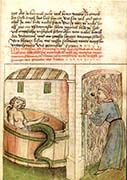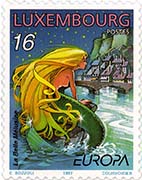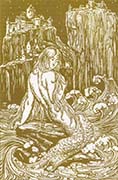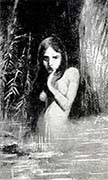
In the Middle Ages, the writing about Melusina had a threefold function: it served aristocratic dynasties to nourish their family-myths and to legitimate and glorify their own ancestry; this is the case for the Luxembourgish dynasty. The alliance of Melusina and Count Siegfried, the founder of the city of Luxembourg, stylises the mermaid to the first female ancestor and progenitor of the Luxembourgers and the protectress of the city. In this regard, Melusina gains in importance during the 19th century, when she plays a role in the shaping of the budding national identity and contributes to the delimitation towards the neighbouring countries Germany, France and Belgium. In World War I and especially World War II, Melusina becomes a symbol of Luxembourgish identity, unity and  independence, concepts that needed to be defended against the German aggressor. At the end of the 20th century, some writers use the Melusina-figure as a spearhead of social criticism, and they often do so in a satirical vein. Due to her hybrid nature – half man, half beast – the figure lends itself also to the literary examination of Luxembourg’s multicultural and multilingual society. In recent years, increasing feminist texts draw the picture of a nonconformist Melusina, who focuses in the conflictual area of gender discourse on subjects such as the construction and the shaping of female identity and personality. Last but not least, there are humoristic adaptations of the Melusina-legend as well as texts in the literature for young people.
independence, concepts that needed to be defended against the German aggressor. At the end of the 20th century, some writers use the Melusina-figure as a spearhead of social criticism, and they often do so in a satirical vein. Due to her hybrid nature – half man, half beast – the figure lends itself also to the literary examination of Luxembourg’s multicultural and multilingual society. In recent years, increasing feminist texts draw the picture of a nonconformist Melusina, who focuses in the conflictual area of gender discourse on subjects such as the construction and the shaping of female identity and personality. Last but not least, there are humoristic adaptations of the Melusina-legend as well as texts in the literature for young people.
Text by Jeff Schmitz www.cnl.public.lu, www.autorenlexikon.lu, www.dictionnaire-auteurs.lu
Back to top



 LUXEMBOURG
LUXEMBOURG



